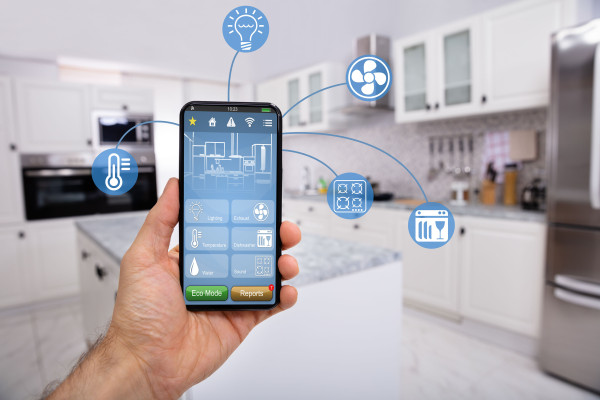Smart home guidelines can help you be energy efficient
Smart homes use technologies with self-learning and algorithms which adapt user needs to electricity supply patterns while providing in-home services when needed.
With the system doing the thinking for us to accommodate our daily energy using behaviours, it can reduce energy when not needed and save on subsequent emissions for a better New Zealand.

A graphic showing the many appliances that can be interacted with in a smart home system.
As the number of electric vehicles and related infrastructure grows, there will be even greater demand for energy at peak times. Homes that integrate smart technology can help reduce energy use and emissions. A new publicly available specification (PAS), SNZ PAS 6012:2022 – Smart home guidelines, is one of a suite of documents sponsored by the Energy Efficiency and Conservation Authority (EECA) as part of its Energy Efficient Homes Strategy.
How smart is your home?
Smart home guidelines will help you understand what a ‘smart home’ is and what you need to do to get started on adapting your home. It introduces the concept of ‘demand flexibility’ and includes an overview of what smart home technology is. It provides guidance for putting together a home energy management system (HEMS) – a combination of interacting electrical appliances and control mechanisms that work together to optimise energy consumption in a home while still meeting the consumer’s needs – and explains how such appliances connect with the electricity grid.
For those that work with smart homes
It also acts as a guide for appliance retailers and suppliers of smart home equipment and services. It contains general smart home information and points those interested in the direction for more detailed information.
Standards New Zealand’s senior standards project manager and energy sector expert Chris Forsman says, ‘We commend EECA for providing access to practical solutions that support all New Zealanders to make more informed choices. Through the range of PAS they have sponsored, we can change the way we live to be more energy efficient and make better choices that have less impact on our environment.’
Created with knowledgeable experts
Feedback garnered through consultation with appliance manufacturers, industry, WorkSafe and the public helped shape the final guide. Although this PAS will not impose any requirements on sellers, importers, or manufacturers, it will enable consumers to make informed choices when buying smart appliances and HEMS.
With this new approach to home electricity use, you can reduce your energy costs, take pressure off our national electricity grid, and help minimise New Zealand’s carbon footprint, all while having the convenience of modern smart technology at your fingertips.
Interested in incorporating this technology into your home? or want to adapt your existing technology to be smart? Start with the SNZ PAS 6012:2022 – Smart home guidelines, access to which has been generously sponsored by the Energy Efficiency and Conservation Authority (EECA), which identified the importance of enabling non-technical users to access a PDF of the good practice guidelines online at no charge.
